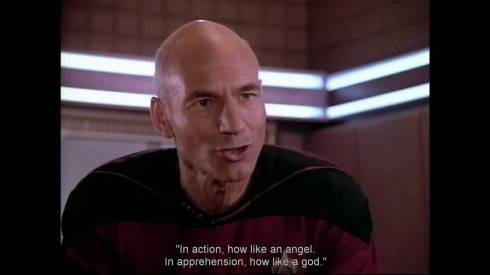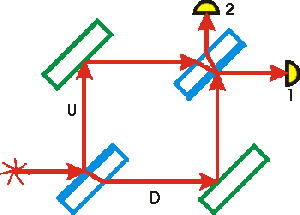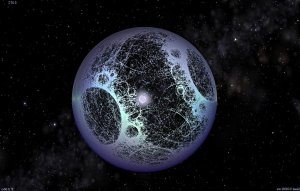You are currently browsing the category archive for the ‘The Beginning of Infinity’ category.
I just finished Steven Pinker’s book The Blank Slate. Good stuff, but the part that is sticking for me today is the poem by Emily Dickinson that he quotes in the final chapter.
The Brain—is wider than the Sky—
For—put them side by side—
The one the other will contain
With ease—and You—beside—
The Brain is deeper than the sea—
For—hold them—Blue to Blue—
The one the other will absorb—
As Sponges—Buckets—do—
The Brain is just the weight of God—
For—Heft them—Pound for Pound—
And they will differ—if they do—
As Syllable from Sound—
I’ve drifted away from Emily Dickinson over the years. This is a poem that I don’t think I ever encountered in my Dickenson-philia phase. If I did, it made no impression. But this time I find it inspiring. It puts me in mind of David Deutsch’s view of the brain as a universal explainer, capable of modeling anything – for instance the inside of a quasar jet.
” . . . one physical system – say, an astrophysicist’s brain – contains an accurate working model of the other, the jet. Not just a superficial image (though it contains that, as well), but an explanatory theory that embodies the same mathematical relationships and causal structure. That is scientific knowledge. Furthermore, the faithfulness with which the one structure resembles the other is steadily increasing. That constitutes the creation of knowledge . . . Of all the physical processes that can occur in nature, only the creation of knowledge exhibits that underlying unity.”
In other words, the brain is wider than the sky, because it can model the sky, and still have room left over. That’s a remarkable fact about brains.
Of course the most important and difficult part of the poem is the final stanza. If you don’t read it carefully, it may sound like traditional religious sentiment. The brain is bigger than this, the brain is bigger than that, but the brain isn’t bigger than God. But Dickinson is tricky. Her religion is never traditional, her view of God anything but sentimental.
“they will differ—if they do—”
Here Dickinson throws doubt on the difference. Did God create man or did man create God? If the brain and God don’t differ, then is God just another model in our expansive brains? But the final metaphor is the crucial one.
“As Syllable from Sound—”
Whatever could that mean?
I think it is a sentiment familiar to Deutsch, familiar to John Gardner in Grendel when he calls humans “pattern-makers,” familiar to Shakespeare when he has Hamlet say of man, “In apprehension, how like a god!”
We are the Children of Tama. We create meaning. We carve “syllable” (sense, explanation, metaphor) from “sound” (nature, experience, event). We do that. If we are different from God (and Dickinson, as we’ve seen, isn’t so sure there’s a distinction to be made) then that difference is found here: we – these embodied brains trapped forever in these limited bodies, yet entirely because of our brains capable of traveling to the bottom of the sea, to the edge of the sky – we transform information into knowledge.
I need to read more Emily Dickinson.
Bill Moyers interviewed Joseph Campbell in a famous series on PBS. I’ve listened to these interviews again and again, and I’ve quoted them many times in this blog. While Campbell’s philosophy was the point of the program, I also got to know a bit about Bill Moyers via these interviews. He’s a religious person, but isn’t afraid to explore his vision of God. I respect that, at least a little.
I recently caught Moyers interview with Neil de Grasse Tyson. Tyson does a great job. Frankly, I wish he’d been able to capture some of this improvised energy in his version of Cosmos. Tyson is at his best when he’s teaching – not reading from a script, but actively teaching another human being, as he is here with Moyers. And Tyson is a great teacher.
But that’s not what I want to write about here.
In the second part of the interview, I think Tyson misses an opportunity.
Moyers – “But do you have any sympathy for people who seem to feel, only feel safe in the vastness of the universe you describe in your show if they can infer a personal God who makes it more hospitable to them, cares for them?”
Tyson – “In this, what we tell ourselves is a free country, which means you should have freedom of thought, I don’t care what you think. I just don’t. Go think whatever you want. Go ahead. Think that there’s one God, two Gods, ten Gods, or no Gods. That is what it means to live in a free country. The problem arises is if you have a religious philosophy that is not based on objective realities that you then want to put in a science classroom. Then I’m going to stand there and say, “No, I’m not going to allow you in the science classroom.” I’m not telling you what to think, I’m just telling you in the science class, “You’re not doing science. This is not science. Keep it out.” That’s where I, that’s when I stand up. Otherwise, go ahead. I’m not telling you how to think.”
Of course. Certainly we want no thought police. Think what you want. But thoughts have consequences. As Robin Williams’ character says in Dead Poets’ Society, “No matter what anybody tells you, words and ideas can change the world.”
Here’s an idea: We’re not safe. A religion that makes us feel safe is dangerous.
The universe is a dangerous place. Worlds collide. Planets are wiped out. Disasters, both natural and human-made, can and do happen. Problems are inevitable. But, as David Deutsch says again and again, problems are soluble. The next disaster is already out there, coming our way, and the only thing between us and that disaster is our knowledge. Not God. Not some cosmic safety net. Not even a security blanket. We, and we alone, can protect us from the very real dangers that are out there.
We need more knowledge. We need to understand the universe better, so that we can control it better. Otherwise it will, without a doubt, kill us. It isn’t pleasant. It isn’t uplifting. But it is crucial information.
That’s what I wish Tyson had said.
A recent discussion about young Earth creationism has got me thinking about my view of the world.
Young Earth creationism (YEC) is such an easy target that is is tempting to be misled, and I realize that I have often fallen into the trap I’ll shortly describe.
YEC proponents claim that the Earth and in fact all the universe is something like six to ten thousand years old, that humans and animals appeared in pretty much their modern form at the beginning of time, that most extinctions occurred and geological formations like the Grand Canyon appeared due to a single worldwide flood, and so on, and that God was responsible for it all. The first part of this argument is so bad that it’s easy to get stuck there, and never get to the second part of the argument, which is in fact infinitely worse. This is the trap.
We can demonstrate that the universe is much older than a few thousand years. We can show that humans and animals have evolved. We can present evidence for the slow formation of landforms. But these demonstrations have no effect on YECs. Why? Because that’s not what YEC is truly all about. Instead, and this is the key point we miss, YEC is actually all about the second statement “God did it.” That’s a statement we can’t refute – which ironically is precisely what makes it such a spectacularly bad explanation.
Old-Earth creationists, intelligent designers, and so on, are far more clever than YECs, and we can see in their arguments the crux (no pun intended) of the issue. They might say, “Fine, we accept all that science and history and geography demonstrate. The universe is 13 some billion years old and began with a Big Bang. But God still did it.” Even though this argument matches (by definition) all the findings of science, it is still a bad explanation.
Let’s set up an imaginary scenario in which YEC or some other similar claim is not such fish-in-a-barrel easy pickings in order to explore why. Suppose an upcoming mission to the Moon discovers, inscribed in the original Hebrew, a replica of the Ten Commandments.
You can imagine the mixture of celebration, consternation, “I-told-you-so” finger wagging, and so on that would ensue. Would this discovery prove the existence of the supernatural entity called God?
Many would be convinced. If I’m honest to my convictions, I have to say that such a discovery would not, in fact could not, convince me. For even with evidence like this, the idea that “God did it” is still a spectacularly bad explanation. If I accept the idea that life (not just science) is all about finding good explanations, then even with the inscribed tablets from the Moon I would have to reject the “God did it” argument as a bad explanation.
What would I say instead? First eliminate the obvious. Is it a hoax? Is this a modern Shroud of Turin, created by Earthlings with an agenda? If we can eliminate that by, perhaps, obtaining an accurate date, demonstrating that this material originated on the Moon itself, showing that the letters were carved in a way inconsistent with a hoax, and so on, then we move on.
Could it be that the tablets arose via natural processes? This is an exceedingly bad explanation. However, it is still better than the idea that a supernatural entity acted in our universe, for the simple reason that the tablets themselves must contain far less unexplained order than the entity that supposedly carved them. Even so, I’d be quite unsatisfied with such an explanation.
No, my conclusion, I believe, would be something like this: the stories of the Old Testament have more truth than I’d supposed. Perhaps there were original tablets, maybe even a person named Moses who received them, and perhaps he even thought he’d received them from God. But such a God, acting in our universe, must be part of our universe, must be, perhaps, a creature like the “Q” of Star Trek, an immensely powerful, knowledgeable, yet still evolved being of our universe, a being that still obeyed and obeys the laws of physics.While we have no evidence for such a race (other than these imaginary tablets, of course), this is still a far better explanation than the supernatural notion that “God did it.” Faced with magic, we must try to discover how the magic works.
What was the point of this imaginary exercise? Just this: the fact that YEC is demonstrably wrong is beside the point. Even if, through some utterly unlikely chain of events, modern science were to discover that the YECs were right all along, that the Earth really is only a few thousand years old and so on, such a discovery in no way validates the much worse claim that a supernatural entity known as God is responsible for our existence. Supernatural explanations are always bad explanations. This is why “debating” YECs (or old Earth creationists, or intelligent design advocates) is pointless.
This argument might feel uncomfortable. It seems like dogma, this out-of-hand denial of the supernatural. Isn’t this the equivalent of a religious claim, an unproved (and unprovable) belief that the universe makes sense? Consider the alternative (which is very much the “world” we live in, and by world I mean society). She claims “God did it”. He claims “The Flying Spaghetti Monster did it”. Another claims Allah, Vishnu, the Raven, the Great Turtle, and so on. Supernatural claims are infinitely variable because they are definitionally untestable. The only path forward we’ve ever found, the only way we’ve ever made any progress, is by assuming that the world makes sense.
Arthur Clarke famously said “Any sufficiently advanced technology is indistinguishable from magic.” Bull, I say! If you believe in reason, you will analyze the “magic”, find out how it works, and change your view of the world to accommodate the new information. But you won’t give up on reason. If we decide that “magic” is both real and unexplainable, we’ve lost.
As I’ve written before, I hate fiction.
Lord of the Flies is a book by William Golding. I read it in high school, and found it both intriguing and terrifying. But now I’ve read Pinker, and I’ve read Deutsch, and that has changed everything.
I just finished Lord of the Flies again. It isn’t hard to sum up the message of the book. “What evil lies in the heart of men (er, um, boys)?” The first time I read the book the message resonated with me. I was deeply interested in the question of evil. Are we basically good, but trapped in a society that drives us to evil acts? Or are we basically evil, with the veneer of society (barely) keeping us from one another’s throats?
It was clear to me then. I was of the former persuasion; this book was of the latter. It was a challenge to me, and I remember convincing myself (rather unconvincingly) that the boys who turned to savagery had been trained by the society in which they were raised. After all, I said to myself, they are only on this island because they themselves were escaping war. War was pounded into their good little hearts from the beginning. How could they have become anything other than what they were? Society made them evil.
Golding, I believe, had just the opposite opinion, and would respond by saying that we had created that society, we had created that war. Even after all the years of bloodshed, we still hadn’t learned our lesson. Here we were, bombing and killing even now as we try to teach our children better.
What a pair of simple souls. Now I know better. The choice is a false one. All evil results from a lack of knowledge. And there was plenty of missing knowledge on that island.
This is not a condemnation of the boys. They were faced with the task of creating a new society. That the society they finally formed was an immoral, irrational, awful mess is no surprise. Almost every society in the history of humankind has been an immoral, irrational, awful mess.
These boys, however, came from the West. They tried to emulate what they’d learned of the grownup world. Ralph found the conch, the symbol of civilization, lawful rule, and reasoned discussion. The boys tried to create knowledge. They used Piggy’s glasses to create fire. They made smoke to send a signal to the outside world. They tried to encourage creative thought and rational criticism. And they almost succeeded.
In the end, they failed. The beast became their god. The conch was destroyed, along with Piggy, the voice of reason on the island. Anti-rational memes are powerful things, and humans are imperfect, prone to error, bound to make mistakes. The biggest mistake of all, the one that proved literally fatal, was the suppression of criticism, the use of violence rather than discussion, the slavish devotion to ritual and superstition instead of creative thought and critical analysis.
But why the beast? Why the failure? What is it about humans that makes us so bad at government? This is what Golding was trying to get at, and where in the end I think he failed, falling back on the evil in men’s hearts business. I don’t know any better than Golding did, but I do know this. It’s easy to be wrong, and hard to be right. All our knowledge is fallible. The West, the Enlightenment, civilization, are far from perfect. But they’re our only hope.
My hope comes from a human trait that Golding little explored, but that I believe is deep and ingrained. When you have a sore in your mouth, you have to touch it with your tongue, even though you know it will hurt. When you hear a bump in the night, you have to go see what it is, even though you may be frightened. When God told Eve not to eat of the Tree of Knowledge, what did she do? Crunch!
The beast was only a dead parachutist. Golding made one enormous error in having only Simon ever try to find this out. We all wanted to know. That’s why Golding told us. The boys would have wanted to know, too. They would have gone. They would have investigated, despite their fear. They would have poked the beast with a stick, ran, slunk back, poked again. Finally, they would have learned the truth.
That same trait, of course, led to the “atom bomb” war that Golding was so convinced was our destiny. The keys to heaven and hell are identical. But we cannot ignore them.
If the beast is in us, as Simon tells learns via the terrifying pig’s head, then our only chance is to go face the beast, journey to the mountain, stare the creature down with the only tools we have, our rational selves.
I’ve said many times that reading The Beginning of Infinity by David Deutsch changed my life. I just today finished Dan Brown’s book Inferno and I’m once again glad I read The Beginning of Infinity first.
SPOILER ALERT!
If you plan on reading Inferno, go do it now, because I’m likely to reveal something in what follows that you wouldn’t want revealed.
OK, see you later.
Wow, back already! You’re a fast reader!
First off, Inferno is a fun if silly book. I know very little about art, and so it was fun for me to hear all the place names, all the cathedrals, all the history of Florence, Venice, and Istanbul (yes, the one in the song). I wanted something light to read over vacation, and Inferno gave me pretty much what I wanted. And who am I to thumb my nose at an author who sells more books in a day than I, well, than I’ll sell. Ever. By a lot. A whole lot.
Anyhow, there’s one facet of Inferno that I have to write about, because it’s an issue of science, and it’s something that not one single character in the book ever questions.
And yet it’s dead wrong.
I wouldn’t have thought so before reading The Beginning of Infinity. Like lots of other smarty-pants people, I thought all our human problems could be traced back to the fact that we keep having all these damn babies. Too many people, too many resources used up, too much of a stress on our environment, beyond the carrying capacity, all that.
Then I read David Deutsch, and everything changed. In Chapter 9 (“Optimism”), Deutsch discusses Thomas Malthus and his predictions of imminent starvation in the late 1700s. Malthus’ predictions didn’t come true because he underestimated the human capacity to create new knowledge. Humans found ways to produce far more food than ever before, and so even though the population increased as Malthus predicted, starvation was not the result.
Again in Chapter 17 (“Unsustainable”), Deutsch tells the story of a lecture by Paul Ehrlich and his very similar predictions of environmental collapse and attendant human suffering. Here’s what Deutsch says:
I can remember when I stopped worrying. At the end of the lecture a girl asked Ehrlich a question. I have forgotten the details, but it had the form ‘What if we solve [one of the problems that Ehrlich had described] within the next few years? Wouldn’t that affect your conclusion?’ Ehrlich’s reply was brisk. How could we possibly solve it? (She did not know.) And even if we did, how could that do more than briefly delay the catastrophe? And what would we do then?
What a relief! Once I realized that Ehrlich’s prophesies amounted to saying, ‘If we stop solving problems, we are doomed,’ I no longer found them shocking, for how could it be otherwise? Quite possibly that girl went on to solve the very problem she asked about, and the one after it. At any rate, someone must have, because the catastrophe scheduled for 1991 has still not materialized.
The reason both Malthus and Ehrlich were wrong is that they forgot something so obvious it almost seems silly to type: we cannot know what we have not yet discovered. People are knowledge creators. Knowledge creation is inherently unpredictable. The reason neither Malthus’ nor Ehrlich’s disasters materialized is that people created knowledge that solved the problems Malthus and Ehrlich posed.
So what does all this have to do with Dan Brown and Inferno? In the book, the villain states that humanity has become too numerous, and that our fecundity will lead to our extinction. His solution? A genetically engineered virus that will randomly sterilize one-third of humanity (OK, now I gave away the ending: sorry, but I did warn you.) All right, so the fictional villain of a summer beach read thriller is a crazy geneticist. Big deal.
But everyone in the book, including the Director of the World Health Organization and also the book’s 208-IQ heroine, agree with the villain! They all think there are too many people. They all think we’re on the path to extinction because of our overpopulation. They all think that sterilizing billions is not so bad.
Not only is this deeply immoral, it is also wrong.
Don’t get me wrong; I think planning your reproduction is a grand thing. Children should be cherished and treasured, and the ability to plan when and where to have them is a crucial human right that everyone deserves. But that choice must be an individual one, not one that’s made by some guy in Florence with a gene sequencer.
The way to reduce population growth is proven. It’s well-known. It works everywhere it is tried. Empower women. Everywhere women are educated, employed, and given basic human rights, the birth rate drops and the quality of each child’s life goes up. We don’t need to sterilize women. We need to teach them to read.
Dan Brown has fallen into the pessimists’ trap. Here’s Deutch again, on
. . . two different conceptions of what people are. In the pessimistic conception, they are wasters: they take precious resources and madly convert them into useless (gadgets) . . . In the optimistic conception – the one that was unforeseeably vindicated by events – people are problem-solvers: creators of the unsustainable solution and hence also of the next problem. In the pessimistic conception, that distinctive ability is a disease for which sustainability is the cure. In the optimistic one, sustainability is the disease and people are the cure.
If I’d read Dan Brown before (or without) reading David Deutsch, I likely would have agreed with the villian (and everyone else) that people are a disease. Now I know better. The only sustainable future is continual progress. Go people!
Richard Feynman made it clear to me in his masterful book, QED: the Strange Theory of Light and Matter. The world is weird. Here’s Feynman’s elegant demonstration.
A laser beam fires photons at a half-silvered mirror. We know very well the properties of photons, and we know from the properties of laser light that the photons from a laser beam are identical to one another. Yet the observation of what happens at that mirror reveals an enormous puzzle.
Half the photons will pass through the mirror. Half will bounce off. How can this possibly be? What possible mechanism can cause identical photons to behave in such a contradictory way? The traditional quantum mechanical answer is, no mechanism at all. The real world is fundamentally random. Set up a device that will kill a cat if the photon is reflected and will spare the cat if the photon passes through, and all you can say is that half the time you’ll have a dead cat. But how? Why? Traditional quantum mechanics goes no further.
I’ve become fascinated with another approach, called many worlds (or the multiverse by David Deutsch and Brian Greene – same thing). Five recent books by five authors have raised more questions than answers, but the journey has been exhilarating.
First came Greene’s book, The Hidden Reality. He talks about many different conceptions of multiple universes, and all made for interesting reading. But the chapter I’ve returned to again and again is Chapter 8 on the Quantum Multiverse. In two long and intriguing end-notes, Greene reveals that he is a proponent of many worlds, and that there is a strong mathematical underpinning to the theory. Interestingly, just reading the text and ignoring the end notes, you might not get this impression.
Next were two books by David Deutsch. I’ve written extensively about how The Beginning of Infinity has changed my worldview. The multiverse Deutsch describes is becoming more and more a part of that view. Chapters 11 and 12, which discuss the quantum multiverse, were in many ways quite difficult, and I’ve reread them several times. They are unwavering in their dedication to the multiverse, and tell much of the story that I’ll outline below.
After Beginning of Infinity, I read Deutsch’s earlier book, The Fabric of Reality. It reads to me almost like a rough draft of Beginning of Infinity. But in chapter 2 of that book, Deutsch describes the straightforward interpretation that leads to the multiverse, including a piece of evidence that is still resonating in my head (also described below).
Next I found a book by Colin Bruce, an Oxford University colleague of Deutsch. The book is called Schrodinger’s Rabbits. Bruce draws heavily on the ideas of Deutsch and others in this book. He also touches on the profound probability problem many worlds faces, and discusses the various suggested solutions. More on Bruce’s curious book in future posts.
Finally I read a book by Brian Cox and Jeff Forshaw called The Quantum Universe. These authors very nearly ignore many worlds until they admit in Chapter Ten that they are essentially using the many worlds approach to obtain their results. Rather than examine the implications of this, they simply quote the oft-cited command to “Shut up and calculate!”
So what’s all the fuss about? I go back to Deutsch and his description of a device called the “Mach-Zehnder Interferometer”.
First (as Feynman describes in QED) a photon enters a beamsplitter. But now we follow the consequences of this apparently random result. In this case the photon is either transmitted (path D) or reflected (path U). Either way, it next moves to a second beamsplitter and then on to a detector.
Now things start getting weird. In every case, the photon shows up at detector 1, never at detector 2. This is due to interference – a careful accounting of how many times the photon’s phase flipped (at each reflection) or was slowed (at each transmission) shows that no photon can be detected at 2.
Wikipedia has a nice description of this if you’re interested:
http://en.wikipedia.org/wiki/Mach%E2%80%93Zehnder_interferometer
The obvious question is, when you’re firing one photon at a time, what is interfering? The many worlds answer, described by Deutsch quite elegantly in chapter 2 of The Fabric of Reality, is “shadow photons.” These have all the properties of real photons, except that they cannot be detected except in their ability to create interference.
Here’s the part that blew me away. Suppose you block one path (maybe path labeled U in the diagram). Now the photon has to move through the interferometer along a single path (path D in this instance). Suddenly photons, arriving only from the lower path, show up in both detectors. But what, exactly, does it mean to “block” one of the paths?
A path is blocked if the photons along that path would be absorbed by the material in the way. OK, let’s suppose we’re using a red laser for this experiment. If we put a red filter (one that allows only red light through) on path U, then we get no effect. Understandable, since essentially adding a red filter changed the setup for red light not at all.
Now replace the red filter with a green filter. The green filter lets green photons through, but it absorbs red photons. Obviously, you’d expect half the red photons (the ones directed to the green filter) to be blocked and not make it to either detector. But now consider a red photon that does reach a detector. It must have traveled along the unblocked path.
What happens when that red photon gets to the second half-silvered mirror? Half the time it goes to detector 1 and half the time it goes to detector 2. Think how strange this is! Take the green filter away, and detector 2 falls silent. No photons reach it. But put the green filter in place and detector 2 wakes up again, catching half the photons that pass through the machine.
You might recognize this as just another instance of the double-slit experiment, and you’d be right. Everything I’m saying here about the Mach-Zehnder Interferometer works as well for the double-slit.
Consider what must be happening to this red photon when the U path is blocked by a green filter. It reaches the first beamsplitter and passes through, following the D path (if it instead were reflected, it would be absorbed by the green filter and disappear, so only half the time will we get the photon we’re interested in). Our red photon then bounces off the lower mirror and heads up to the second beamsplitter. Once there, it either passes through again (reaching detector 2) or reflects off the second beamsplitter (reaching detector 1). It’ll do each about half the time.
But if the green filter is replaced with a red filter, when our photon reaches the second beamsplitter interference effects cause it to pass only, always, every time, into detector 1. Somehow, when our red photon reached the second beamsplitter it “knew” not only that there was some object on the U path (a path that it could not have taken), but also what color that object was!
Traditional quantum mechanics would state that the color of the filter must be taken into account when deriving the entire wavefunction of the system. That’s OK when you think of a laboratory, maybe. But there’s nothing (in principle) to stop us from building a Mach-Zehnder interferometer the size of the solar system, or the galaxy. Are we to believe that the photons here, in our lab, somehow “know” what color the filter was stationed several light-hours (or even several thousand light years) away?
To me, the many worlds interpretation, in which the “shadow photons” Deutsch describes are real, makes much more sense. The shadow photons act like real photons. They react with filters exactly as real photons would, and yet they are undetectable except due to the interference effects they display. I know this isn’t in any sense proof, or even a particularly sound argument (after all, any barrier is translucent to some sort of photon). Somehow, though, for me it really makes an impact.
The Mach-Zehnder interferometer behaves exactly as if the photon really does split into innumerable photons at the first beamsplitter, with half taking the U path and half taking the D path. If there’s a green filter on the U path, all those photons are absorbed and photons on the D path enter both detectors. If there’s a red filter, instead, the photons on the U path fly straight through, meet the photons from the D path, and interfere so that only detector 1 ever records a photon. Many worlds gives us a straightforward way of understanding what happened and why.
But wait. If those shadow photons are absorbed by the green filter, can’t we detect that? Can’t we measure a temperature increase, a momentum shift, something? The answer is yes, if those shadow photons are absorbed by a green filter in our universe. But in fact no such effect has ever been found. Instead, the shadow photons are absorbed not by an object in our universe, but by a shadow filter. And if a shadow filter, there must be a shadow laboratory with shadow scientists who can now detect that shadow photon with their own shadow instruments. Taken to its logical conclusion, many worlds reveals a universe in which even we are but one instance of a vast collection. It seems utterly incomprehensible, yet that’s where the logic leads.
Now that I’ve written about the basics of many worlds, I’ll explore those logical, but utterly bizarre, conclusions in future posts. This one’s long enough already. At least in this universe.
Homer Simpson once said of the USA Today that it is the only newspaper that isn’t afraid to tell the truth – that everything is just fine!
I’m a little bit afraid that I’m becoming a Homer. A few years ago I became interested in the idea of “peak oil.” At the time I was working on an article about petroleum and I read a book by David Goodstein, of Mechanical Universe fame (ok, fame for me. I’ll admit it’s a little weird that I know more physicists by name than rock stars).
Anyway, Goodstein’s book, Out of Gas, is pretty grim regarding the future. Goodstein and others say that oil, as a finite resource, must eventually become scarce. When demand outstrips supply, oil will become too expensive to use, and essentially all our technology will grind to a halt.
At the same time, I read another book, skeptical of the idea of peak oil. This book was by a free-market economist named Peter Huber and a physicist named Mark Mills. It was called The Bottomless Well. In the book, the authors made the argument that we will never run out of energy because energy begets energy. Sounded like a pretty crazy idea at the time, and I mostly discounted what they had to say.
But even then something about their optimism regarding human ingenuity struck me as a powerful idea. I guess it stayed with me more than I knew, because as I read Beginning of Infinity, I recalled this strange energy book I’d read earlier. Recently I returned to The Bottomless Well and read it again.
Like Deutsch in BoI, the authors of The Bottomless Well present some deeply counter-intuitive ideas. The first is that energy is not what we’re after at all. Instead it’s order that we seek. In fact, we use up most of the energy we collect in transforming energy from less-ordered to more-ordered.
One great example is how we make and use electricity. There’s a commercial I’ve seen in which laptops and mp3 players are powered by gasoline. The reason this is silly isn’t that gasoline is polluting. It’s that gasoline lacks the order needed to operate things like laptops.
When we burn coal or oil to make electricity, we aren’t just transforming one kind of energy into another. The transformation process is never 100% efficient – far from it. When we transform energy we lose most of it, but we end up highly-ordered energy that we use to run laptops, lasers, and surgical robots. Much of The Bottomless Well is about how much energy we waste in creating order in the form of electricity. This waste is both necessary and good – the more energy we waste in this way, the more possibilities we create.
Another counter-intuitive idea is that energy efficiency is self-defeating. Consider the first computers. With their rooms full of vacuum tubes to perform even the simplest arithmetical tasks, they were amazingly inefficient. My laptop today is vastly more powerful and hugely more efficient than the most powerful computer on the planet sixty years ago. Yet it is just this efficiency, made possible by transistors and then integrated circuits, that has caused the total energy used by computers today to skyrocket. Efficiency doesn’t let us do less, it encourages us to do more. Therefore energy efficiency will always lead to more consumption, not less.
One of the most memorable parts of the book was the allusion to the coal problem in the early 1800s. Everyone knew that coal was a vastly superior fuel to wood, which in any case was dwindling away. But how to move the coal, heavy and bulky, from where it was found to where it was needed? In the end, through the invention of the coal-fired pump and the coal-fired steam locomotive, the coal moved itself. Energy begets more energy.
It’s a powerful, optimistic view of human potential that serves as a fine sequel to Deutsch’s book. As a dyed-in-the-wool liberal, I remain skeptical of the authors’ faith in the free market to find the best solution to every problem. But I also recognize that I still have lots to learn. An infinite amount, in fact.
Of course we’ll run out of oil someday. Problems are inevitable. But problems are also soluble. All evil results from a lack of knowledge. The answer to our problems isn’t to pull back. It’s to move forward, actively searching for more knowledge, more solutions, more sources of ever better energy. Of course those energy sources will be imperfect, and will lead to new problems. Problems are inevitable. But, with enough knowledge, problems are soluble.
Near the beginning of The Beginning of Infinity, David Deutsch writes, “One of the most remarkable things about science is the contrast between the enormous reach and power of our best theories and the precarious, local means by which we create them.” This remarkable thing first struck me when I read a book called The Universe written in 1966 by Isaac Asimov. Before reading this book, I had some vague notion that science had some sort of black box into which light went and out of which came all sorts of information. In Asimov’s book, for the first time, I recognized that every piece of knowledge we have is a prize that had to be won with imagination and hard work.
Lawrence Krauss’s new book A Universe From Nothing takes me down the same path I first traveled with The Universe. Krauss’s book is quite short, but doesn’t shy away from the thing that makes science so different from every other field. In science, it’s not just what you know, it’s how you know it. It’s how you got there, what were your methods, your tools, your approach. Beginning with Einstein’s update of Newton, Krauss takes us through the discovery of the Big Bang, the flatness of space, inflation, dark matter, and the surprising discovery of dark energy. It all hangs together so elegantly, and has the added benefit of serving as a logical sequel to The Universe.
One of the very best parts of the present book is Krauss’s contrast of two predictions. One he calls the best prediction in all of science. The other he calls the worst prediction in all of science. Amazingly, they both have to do with the same idea: virtual particles.
The best prediction is of the affect of virtual particles on a hydrogen atom. A hydrogen atom looks pretty simple; a single electron moving around a single proton. Yet the forces between these two charged particles didn’t come out right until virtual particles, particles that pop in and out of existence all the time between and near the proton and electron, are taken into account. When these affects are included, the answer matches experiment to within one part in a billion. That’s pretty good figuring, and is powerful evidence that scientists are on to something.
And yet, when virtual particles are included in the calculations of empty space, the result is wrong by 120 orders of magnitude, making this the worst prediction in the history of science (the same terrible prediction Leonard Susskind discussed in The Cosmic Landscape.)
Clearly there’s a lot we still don’t understand about virtual particles.
So why is there something rather than nothing? “Nothing”, it seems, is unstable. Given enough time, something like our universe appears inevitable. There’s also a nice discussion of why, when we consider gravitational as well as other forms, the total energy of the universe is in fact always zero. The universe is the ultimate free lunch. It’s just one of those things, like particle-antiparticle pairs, that happens from time to time. Given the levels of uncertainty we still have about the dark energy problem, quantum gravity, and so on, there’s certainly nothing like a proof that the universe emerged from nothing. However, as Krauss points out, just the fact that such an idea is now plausible is quite telling. There’s still lots more to learn, and of course that’s the best part.
One part of the book that I have to disagree with, though, is Krauss’s pessimism about the future, on at least two counts. First, Krauss says that in the far future cosmology will be impossible. All the galaxy clusters will have disappeared beyond the horizon, and even the glow of the cosmic background radiation will be too faint to detect over the light noise of the galaxy. Second, Krauss says that even farther in the future, life itself will become impossible as the universe becomes utterly dilute and void of useful energy.
As David Deutsch points out, this need not be so. Krauss’s vision is one in which knowledge plays no role. But Deutsch recognizes that knowledge is a fundamentally different, and transformative, thing. With the right knowledge, anything is within our grasp. Just as today we are not dependent upon cloudless skies to do astronomy, in the far future we may not be dependent on seeing through the “noise” of our own galaxy. And as we gain even more transformative ability, we may well discover new sources of evidence that today we don’t dream of. Given the history of science so far, it would be surprising were this not to happen.
The far future is also not so gloomy as Krauss suggests. Given enough knowledge, we may even find a way to harness dark energy. As the universe expands, dark energy expands with it, never growing dilute. This could become a truly infinite, inexaustible supply of energy, with which people (undoubtedly very different from the naked apes that first appeared on Earth billions or even trillions of years earlier) could become masters of the entire universe. Krauss doesn’t think such a people-centered universe could come about, or perhaps just doesn’t consider it. But as Deutsch shows us, we could choose to make it happen. It’s up to us.
I don’t have much to say about this book. Deutsch writes of the Copenhagen Interpretation that “It’s disparagement of plain criticism and reason as being ‘classical’ and therefore illegitimate, has given endless comfort to those who want to defy reason and embrace any number of rational modes of thought. Thus quantum theory – the deepest discovery of the physical sciences – has acquired a reputation for endorsing every mystical and occult doctrine ever proposed.”
You’ll find many of those mystical and occult doctrines championed by the heroes of How the Hippies Saved Physics. Sure, quantum encryption is pretty cool, and it was because the “hippies” of the title got it so wrong that others got it right. In my mind, that’s not a ringing endorsement of their methods. I would have liked the author to point out that things like ESP, clairvoyance, and telekinesis actually don’t work. One would think, given null result after null result, that the physicists profiled in this book would have eventually gotten the idea. But many of them are still championing the same flapdoodle even today.
Quantum mechanics is amazing enough without having to add mysticism and nonexistent forces to it. Don’t waste your time with this book.
I finished The Fountainhead for a second time. I was spurred to read it by my disappointment at the Beginning of Infinity community. I sense in many of them the sort of libertarian over-indulgence I found in Ayn Rand in The Fountainhead. I wanted to go back and try to understand how and why Rand came off the rails, to see if perhaps I could sense the same failure in the real-life philosophy of the BoI community.
At one point in the book, Catherine shouts out, “I’m not afraid of you, Uncle Ellsworth!” It was tragic, because it was the last truly independent act Catherine would undertake. Hopefully my title won’t lead me to a similar fate.
I really do love parts of The Fountainhead. OK, the rape scene (really!) is an unnecessary vulgarity and a portent of the further vulgarities to come. But other than that, I really do admire Howard Roark’s sense of self-worth and self-satisfaction. Every humanist should read the section on Roark’s Stoddard Temple. This is a place I wish I could visit, and Howard Roark built it.
But now that I’ve read the book a second time, I see Rand’s mistake. The Howard Roark who build the Stoddard Temple never would have worked in secret on the Cortlandt project. The Howard Roark who built the Heller House and the Cord Building and the Enright House would have gone to the committee himself, stated his terms, then walked out when they refused him.
Why doesn’t the Howard Roark (now a much more established architect) of the second part of the book do just this? If he’s interested, he should say so, and say how he would do the work. Maybe (ok, probably) they’d refuse him. But their inability to accept Roark’s conditions are exactly what make Roark’s scheme with Peter Keating untenable. Roark’s experience (we assume the same experience that keeps him from going for Cortlandt in the first place) should have told him that his deal with Keating was doomed to failure.
When Roark saw Cortlandt perverted, he should not have been surprised. Roark’s character fell apart with his secret deal with Peter Keating, not with his illegal dynamiting of a building that wasn’t his. That was Ayn Rand’s mistake. Roark’s dynamiting of Cortlandt was not a necessary consequence of his philosophy. Instead, the whole Cortlandt episode was a failure of Howard Roark to live up to his own ideals.
So there, Ayn Rand. You don’t scare me anymore.
Now back to my regularly scheduled non-fiction.








